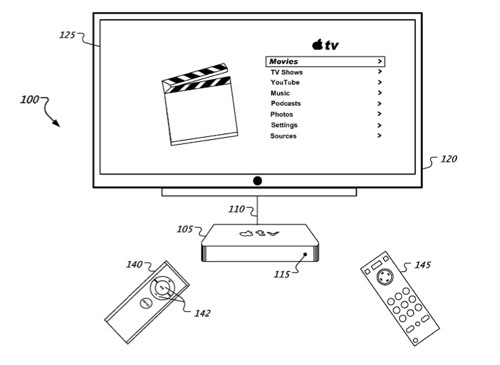For those hoping for a long-overdue update/overhaul to the Apple TV, two new Apple patents at the US Patent & Trademark Office offer hope. They hint at future Apple TVs that can be controlled by HDTVs and DVRs, as well as some iPhone/iPad-ish features.
Patent 20100123834 is for a system and method for capturing remote control device signals. The invention relates to media processing devices, and to systems and methods for capturing by a media processing device remote control device command signals, such as navigation and playback commands, from a plurality of remote control devices.
Methods, systems, and apparatus for learning remote control command signals by a media processing device. In one aspect, a method includes activating a learning mode of operation, presenting an instruction to actuate a control associated with a secondary remote control device, capturing a command signal transmitted by the secondary remote control device while the learning mode is active, generating a mapping that associates a representation of the captured command signal with a media processing device function, and storing the generated mapping in a profile corresponding to the secondary remote control device.
Further, a control symbol identifying the control associated with the secondary remote control device can be displayed. Additionally, a progress bar can be displayed indicating a period for which the control is to be actuated. The inventors are Rainer Brodersen, Stephanie Cinereski and Jack I-chieh Fu.
Here’s Apple’s summary of the invention: “Media processing devices can be configured to process and playback media content that contains audio, image, and/or video content. Playback of media content can be controlled through the input of commands, such as pause, rewind, and stop. Additionally, one or more menus associated with the media content, such as chapter or feature menus, can be traversed in a user interface in response to one or more input commands.
“A media processing device can incorporate a user interface that includes one or more controls, such as buttons, switches, and dials. The controls can be actuated to input commands for directing playback and navigation. Further, some media processing devices can include a remote control device configured to transmit command signals, such as infrared (IR) or radio frequency signals, representative of commands entered using the remote control device. For example, a remote control device can include a plurality of controls, such as buttons and switches. A simple command can be indicated by a single control, such as a button push.
“Further, a complex command can be indicated by a combination of controls, such as simultaneous or sequential actuation of multiple buttons. Also, a brief actuation, such as a button push, can be distinguished from a continuous actuation, such as a button hold, and the corresponding command signals can be interpreted differently. For example, a control can be deemed to be actuated for as long as the command signal events are received within a predetermined time window, and the control can be deemed to be held if it is in a continuously actuated state for a predetermined amount of time.
“Each command signal transmitted by the remote control device can correspond to an action the media processing device is to perform. A media processing device can be configured to recognize a predetermined set of command signals and can perform actions corresponding to the command signals transmitted by an associated remote control device. Also, universal remote control devices have been developed that can transmit command signals associated with a plurality of different command formats or protocols. Thus, a universal remote control device can be programmed to transmit commands corresponding to a plurality of remote control devices and can thereby control a plurality of media processing devices. However, each media processing device responds only to the set of command signals it is configured to recognize.
“A media processing device, such as the AppleTV distributed by Apple Inc. of Cupertino, Calif., can be configured to recognize command signals transmitted by a primary remote control device corresponding to the media processing device and a plurality of secondary remote control devices. The secondary remote control devices can be remote control devices associated with other devices from the same manufacturer as well as third-party remote control devices. Further, the command signals can be transmitted using a plurality of different protocols and/or formats.
“Additionally, a media processing device can be configured such that multiple secondary remote control devices can be active at the same time. In order to permit the use of a secondary remote control device with a media processing device, the present inventors recognized that it was beneficial to permit the media processing device to map a command signal transmitted by the secondary remote control device to a function that can be performed by the media processing device.
“The present inventors also recognized a need for a media processing device to map command signals associated with a secondary remote control device to at least each of the basic control functions that can be performed using the primary remote control device. Further, the need to map a media processing device function to any control included on a secondary remote control device also was recognized. Additionally, the present inventors recognized the need to provide an indicator, such as turning off a light emitting diode (LED), when the media processing device recognizes a command signal transmitted by a remote control device. Accordingly, the techniques and apparatus described here implement algorithms for recognizing and mapping by a media processing device one or more command signals transmitted by a secondary remote control device to functions that can be performed by the media processing device.”
Patent 20100123834 is for a system and method for capturing remote control device command signals.
Methods, systems, and apparatus for identifying protocols. In one aspect, a method includes comparing characteristics of a wireless signal received from a remote control to characteristics associated with a set of protocols. The method also includes assigning a score, based upon the comparison, to each protocol included in the plurality of protocols. The method also includes identifying a protocol from the set of protocols based upon the assigned scores. The identified protocol is substantially similar to a protocol associated with the wireless signal. The inventors are, once again, The inventors are Rainer Brodersen, Stephanie Cinereski and Jack I-chieh Fu.
Here’s Apple’s summary of the invention: “A media processing device, such as the AppleTV distributed by Apple Inc. of Cupertino, Calif., can be configured to recognize command signals transmitted by a primary remote control device corresponding to the media processing device and a plurality of secondary remote control devices. The secondary remote control devices can be remote control devices associated with other devices from the same manufacturer as well as third-party remote control devices.
“Further, the command signals can be transmitted using a plurality of different protocols and/or formats. Additionally, a media processing device can be configured such that multiple secondary remote control devices can be active at the same time. In order to permit the use of a secondary remote control device with a media processing device, the present inventors recognized that it was beneficial to permit the media processing device to map a command signal transmitted by the secondary remote control device to a function that can be performed by the media processing device.
“The present inventors also recognized a need for a media processing device to map command signals associated with a secondary remote control device to at least each of the basic control functions that can be performed using the primary remote control device. Further, the need to map a media processing device function to any control included on a secondary remote control device also was recognized.
“Additionally, the present inventors recognized the need to provide an indicator, such as turning off a light emitting diode (LED), when the media processing device recognizes a command signal transmitted by a remote control device. Accordingly, the techniques and apparatus described here implement algorithms for recognizing and mapping by a media processing device one or more command signals transmitted by a secondary remote control device to functions that can be performed by the media processing device.
“In some implementations, a method includes comparing characteristics of a wireless signal received from a remote control to characteristics associated with a set of protocols. The method also includes assigning a score, based upon the comparison, to each protocol included in the plurality of protocols. The method also includes identifying a protocol from the set of protocols based upon the assigned scores. The identified protocol is substantially similar to a protocol associated with the wireless signal.
“In other implementations, a media processing device includes a receiver for receiving a wireless signal from a remote control. The media processing device also includes a remote control driver for comparing characteristics of the wireless signal to characteristics associated with a set of protocols. The remote control driver is configured to assign a score, based upon the comparison, to each protocol included in the set of protocols. The remote control driver is further configured to identify a protocol from the set of protocols based upon the assigned scores. The identified protocol is substantially similar to a protocol associated with the wireless signal.
“In still other implementations, one or more computer readable media store instructions that are executable by a processing device, and upon such execution cause the processing device to perform operations that include comparing characteristics of a wireless signal received from a remote control to characteristics associated with a set of protocols. The operations also include assigning a score, based upon the comparison, to each protocol included in the set of protocols.
“Operations also include identifying a protocol from the set of protocols based upon the assigned scores. The identified protocol is substantially similar to a protocol associated with the wireless signal.
“The techniques described in this specification can be implemented to realize one or more of the following advantages. For example, the techniques can be implemented such that a media processing device can be programmed to receive and recognize commands from a plurality of remote control devices, including secondary remote control devices. The techniques also can be implemented to permit mapping a control signal associated with any control of a secondary remote control device to a specific function of the media processing device.
“Further, the mappings corresponding to a secondary remote control device can be stored in a device profile. Additionally, the techniques can be implemented to permit renaming a remote control device profile stored on the media processing device, deleting a remote control device profile, or remapping at least a portion of a remote control device profile. The techniques also can be implemented such that one or more remote control device profiles are preloaded on the media processing device, such as for widely-used secondary remote control devices. The techniques further can be implemented to permit presenting an interface for guiding a user through the creation of a remote control device configuration.”






